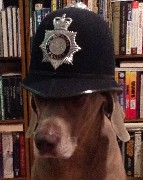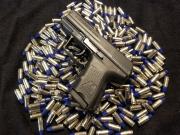WARNING!! Flashlight nerd post ahead!
Not to turn this into a Show 'n Tell thread, but I would like to illustrate how today we have the luxury of being able to assemble a light for specific applications - in this case, a hand held light configured specifically for defensive purposes (with or with a handgun).
As already indicated in previous posts, here are the attributes
I want in a light for this purpose;
Single output mode. Regardless of the UI, a multi-output light can end up not providing maximum output in that split-second of immediate need.
Blinding output. Most make the mistake of using just the lumens rating for this measure and not consider the rated candela or lux rating (how tightly the lumens are focused in a central hot spot). Being able to "laser" the target's eyes with a column of focused light is a huge benefit. At the same time the column (hot spot) needs to be wide enough to not require precise light aiming and provide enough spill to maintain SA with periphery vision. In terms of absolute ratings I have found that more-is-better, with around 10,000 candela/lux and 600 lumens the minimum I would want for this application.
Simple UI. This is really the most important to me, and as @
SoCalDep stated:
If you want to be good at fighting get a single-mode light that turns on when you press the tailcap switch and turns off when you release it. Based on spending a day of instruction in the dark using a hand held to engage targets with a pistol, this is truly excellent advice.
Light ergonomics. I had taken both a small (but capable) pocket light and a larger 3-cell light with me to the training. Under the stress of having to clear stoppages, make mag changes, etc. I found the larger light easier to handle and maintain a good grip on.
Built like a hammer. It's gotta be built like a tank to withstand physical abuse, whether that's being repeatedly dropped and hitting the pavement or being used as an impact tool.
Flexible power supply. Can be run on either Li-ion rechargeable cells or ordinary CR123A batteries. Being able to quickly change cells in the field is IMO a requirement.
Based on what I learned, I have since assembled the light below which checks all the boxes for this niche purpose;

Starting from the back of the light;
Surefire "twisty" tailcap. Press the button to turn the light on, let it go to turn it off. If constant-on is needed, twist the tailcap tight to the body. One thing I discovered is that "clicky" tailcap switches can accidently be clicked to constant on, which sucks when I release the button and expect the light to turn off immediately.
Finger lanyard. Amazing how useful this feature is for controlling the light and retaining it when both hands are needed (clearing stoppages, mag changes, etc.). The DIY lanyard is attached to a Raven Concealment clip which due to it's split-ring construction will pull off the light if an adversary gains control of the light with my finger still in the lanyard.
Malkoff MD3 body. Holds two 18500 Li-ion cells or three CR123A batteries, and is long enough to get a full-hand grip on.
Malkoff M91T head. Single mode, 750 lumens/19,000 lux with over an hour of full output run time. The TIR lens focuses most of the lumens into a wide central hot spot while providing adequate spill.
This light rides comfortably clipped in a front pants pocket where it's readily accessible (can also be easily carried in a kydex flashlight holster). If the light needs to be deployed quickly, there is
zero doubt what's going to happen when the button is pressed. Yes, it's a niche light but is IMO about as good as it gets for this purpose. When I return to the Sig Academy to take the half-day Low Light Pistol Operator refresher course, this will be the light I'll take.
If all I need to do is find the keys I dropped, a small EDC multi-mode light that rides in the bottom of my pocket is used for that;

I hope you find this post informative.




 Reply With Quote
Reply With Quote







